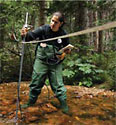
 Scientists study water-quality variation and disturbance impacts in Colorado’s biggest park
Scientists study water-quality variation and disturbance impacts in Colorado’s biggest park
Student Focus:
Leigh Cooper
Pine beetles are turning large swaths of forest in the western United States and Canada red. While many people worry about how the beetle kill will affect forest fires, CIRES graduate student Leigh Cooper wants to know what effect beetle kill is having on water quality.
“When forest disturbances like logging or fire occur, you usually see a large influx of nitrate into local streams, since the trees in the area no longer actively take up the nutrient,” Cooper said. “I wanted to explore whether you would see a similar influx of nutrients into streams in Colorado watersheds affected by beetle kill.”
Cooper is working towards a Ph.D. in Ecology and Evolutionary Biology at the University of Colorado at Boulder. Her research was partly supported by a 2008 CIRES Graduate Research Fellowship.
So far, Cooper’s stream chemistry tests have not revealed a straightforward link between beetles and nitrate, but the results suggest interesting hypotheses she can test further. “Within CIRES’ interdisciplinary research environment, I’m able to study freshwater ecology,” Cooper said, “and soil and watershed chemistry, too.”
 Ecology student Leigh Cooper studies the effects of beetle kill on Rocky Mountain water quality.
Ecology student Leigh Cooper studies the effects of beetle kill on Rocky Mountain water quality.
CIRES offers two graduate fellowships, ranging in support from a summer or single semester to four years. The new ESRL-CIRES fellowship allows students to work with world-class researchers at NOAA’s Earth System Research Laboratory while earning a degree at the University of Colorado at Boulder.
![]() Learn more about CIRES fellowships at cires.colorado.edu/education
Learn more about CIRES fellowships at cires.colorado.edu/education
The removal of a watershed’s natural vegetation by fire reduces the ability of plants to take up nitrogen and other soil nutrients, McCutchan said. As a result, rain and snowmelt tend to flush nitrogen directly into the stream channel.
“Nitrogen is a very important nutrient in streams and can alter the growth of photosynthetic organisms,” said McCutchan. “Ultimately this may affect the whole food chain, including top-level fish like Colorado’s threatened greenback cutthroat trout.”
Nutrient changes in the park’s high-altitude streams also can affect water quality far downstream. The headwaters of the Colorado, St. Vrain and Big Thompson rivers, which supply drinking and irrigation water to Colorado communities, are all located in RMNP. CIRES conducted “Water Blitz” in both 2008 and 2009.
“It’s a great study because it combines questions about current stream chemistry… with questions about how to best monitor streams into the future,” said RMNP Research Administrator Judy Visty. ![]()
On an August day in 2009, roughly 100 hikers fanned out across Rocky Mountain National Park (RMNP) carrying water bottles—not to quench their thirst, but to collect water samples for scientists.
By analyzing water collected simultaneously from 250 locations on both sides of the Continental Divide, CIRES and National Park Service researchers hope to better understand how climate, pollution, and ecological disturbances affect water quality.
“We want to understand how water quality varies spatially in Rocky Mountain National Park and refine our understanding of what’s causing these differences,” said project leader James McCutchan, Associate Director of CIRES’ Center for Limnology.
Basic environmental factors, such as hill slope, vegetation type, and bedrock mineral composition affect stream chemistry, said McCutchan, but he also expects to see significant differences between watersheds that have been disturbed by wildfire or mountain pine beetle, and undisturbed watersheds.


